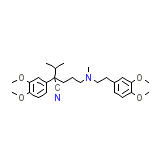Dilacoran




Categorie
Dilacoran Les marques, Dilacoran Analogs
- Apo-Verap
- Arpamyl
- Berkatens
- Calan
- Calan SR
- Cardiagutt
- Cardibeltin
- Cordilox
- Covera-HS
- Dignover
- Dilacoran
- Drosteakard
- Geangin
- Iproveratril
- Isoptimo
- Isoptin
- Isoptin SR
- Novo-Veramil
- NU-Verap
- Quasar
- Securon
- Univer
- Vasolan
- Veracim
- Veramex
- Verapamil HCl
- Verapamil [Usan:Ban:Inn]
- Verapamilo [Inn-Spanish]
- Verapamilum [Inn-Latin]
- Veraptin
- Verelan
- Verelan PM
- Verexamil
Dilacoran Les marques melange
Dilacoran Formule chimique
Dilacoran RX lien
Dilacoran FDA fiche
Dilacoran msds (fiche de securite des materiaux)
Dilacoran Synthese de reference
Dilacoran Poids moleculaire
Dilacoran Point de fusion
Dilacoran H2O Solubilite
Dilacoran Etat
Dilacoran LogP
Dilacoran Formes pharmaceutiques
Dilacoran Indication
Dilacoran Pharmacologie
Dilacoran Absorption
Dilacoran Toxicite
Dilacoran Information pour les patients
Verapamil HCl is known as a calcium channel blocker. It is taken to treat high blood pressure, to relieve some chest pains in patients with angina, or to treat some problems with heart rhythms. Verapamil has several drug interactions, make sure your physician and pharmacist known all the medicines you are taking so they may properly advise you. Verapamil HCl is excreted in breast milk. It may be necessary to change therapy or provide an alternate to breast milk. The most common side effect is constipation. This may be relieved with dietary modification (more fiber) or laxatives. Sustained release tablets should be taken with food. They should not be broken or crushed. Doses may need some adjustment, make sure to have your condition monitored regularly.














